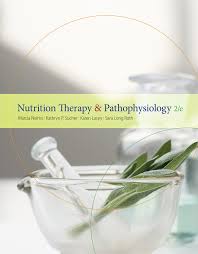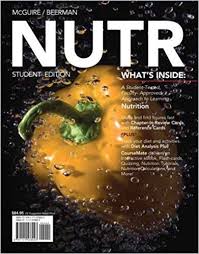Test Bank For Nutrition Therapy And Pathophysiology 2nd Edition by Marcia Nahikian Nelms
Original price was: $75.00.$35.00Current price is: $35.00.
Test Bank For Nutrition Therapy And Pathophysiology 2nd Edition By Marcia Nahikian Nelms is a reliable resource for college students taking the nutrition therapy course. The book provides detailed information on pathophysiology and various disorders related to nutrition.
In addition, the Test Bank For Nutrition Therapy And Pathophysiology 2nd Edition By Marcia Nahikian Nelms comes with a CD that includes practice quizzes and other materials to help students prepare for their exams. I highly recommend this book to any college student taking a nutrition course.
Digital item No Waiting Time Instant Download
Description
Test Bank For Nutrition Therapy And Pathophysiology 2nd Edition by Marcia Nahikian Nelms
Chapter 3 – Nutrition Assessment: Foundation of the Nutrition Care Process
Multiple Choice
An. Type Page(s) Note: Under Type, K = knowledge and A = application.
a K 35 1. Determination of _____ involves an attempt to project potential nutrition problems based on the client’s current health status.
a.nutritional risk
b.nutritional status
c.nutrition screening
d.nutritional assessment
c K 35-36 2. Which of the following is not a component of a nutritional assessment?
a.estimation of protein and energy needs
b.determining potential drug and nutrient interactions
c.patient filling out hospital nutrition forms
d.nutrition-focused physical exam
d K 36 3. The process of identifying patients, clients, or groups who may have a nutrition diagnosis and benefit from nutritional assessment and intervention by an RD is defined as:
a.nutrition-focused physical examination.
b.nutritional assessment.
c.estimating nutritional needs.
d.nutrition screening.
b A 36 4. If your patient reports that he/she has nausea after eating and vomits one time per day, this type of data is considered to be:
a.objective.
b.subjective.
c.biochemical.
d.clinical.
a A 36 5. If you read a patient’s medical record and obtain information such as previous medical or surgical history, this type of data is considered to be:
a.objective.
b.subjective.
c.biochemical.
d.clinical.
c K 37 6. Which of the following is an important consideration in obtaining dietary information from a patient?
a.the dietitian’s credentials
b.the type of supplements that your facility offers
c.the rapport between the RD and the patient
d.how much the patient is eating during the admission
b K 37 7. Which of the following is not a component of a thorough diet history?
a.patient’s food preferences
b.patient’s previous medical history
c.the patient’s use of complementary and alternative medicine
d.patient’s cultural, religious and ethnic beliefs
c K 38,40 8. Which of the following tools for gathering dietary information is prospective in nature?
a.24-hour recall
b.food frequency questionnaire
c.food record
d.usual intake pattern
d K 44-45 9. Which of the following statements is not true?
a.The AI, RDA, UL, and EAR are all part of the DRI.
b.One method of assessing a patient’s diet is by comparing it to the USDA’s MyPyramid.
c.The DV were established to assist the consumer in interpreting nutrition information.
d.Comparison using the USDA’s MyPyramid will quantify the client’s macro- and micronutrient intake.
c K 46 10. Which of the following methods of measuring or estimating height requires the use of a calculation?
a.recumbent length
b.use of stadiometer
c.knee height
d.arm span
d A 46-47 11. You are conducting a nutritional assessment on a patient who has a below-the-knee amputation. When estimating his adjusted weight in order to calculate BMI, you would divide his current weight by:
a.70%.
b.99%.
c.81.4%.
d.92.9%.
b K 47 12. Which of the following measures of anthropometrics in infants would warrant further assessment to confirm any health problems?
a.low estimated height
b.<3% or >97%ile for the growth charts
c.an unusual weight for height pattern
d.a small head circumference
c K 48 13. Which of the following measures estimates risk of type 2 DM?
a.elbow breadth
b.wrist circumference
c.waist circumference
d.measured weight
a K 51 14. A procedure that utilizes a small, low-frequency electrical current to estimate body cell mass and fat-free mass is termed:
a.BIA.
b.hydrodensity.
c.NIR.
d.DEXA.
b K 53 15. Which type of protein refers to skeletal muscle?
a.visceral
b.somatic
c.mid-arm muscle
d.dietary
c A 47,53-54 16. Your patient has renal disease and you are assessing her nutritional status. Which of the following measures would be least useful in this situation?
a.nitrogen balance
b.CHI
c.height
d.weight
b K 55 17. Which of the following biochemical measures is the most valid for measuring nutritional risk due to its short half life of 2-3 days?
a.transferrin
b.prealbumin
c.albumin
d.H/H
a K 55-56 18. Which of the following is not an acute-phase protein?
a.3-methylhistidine
b.RBP
c.CRP
d.prealbumin
a K 58 19. The purpose of the _____ is to assess the patient for signs and symptoms consistent with malnutrition using techniques such as palpation.
a.nutrition-focused physical exam
b.nutrition screening
c.nutritional assessment
d.nutrition education
c K 58 20. A visual assessment of the body conducted in a systematic manner by a clinician during a nutrition-focused physical exam is termed a(n):
a.palpation.
b.percussion.
c.inspection.
d.auscultation.
b K 58 21. If the clinician uses sound to assess the GI tract by tapping with his or her fingers during a nutrition-focused physical exam, this technique is termed:
a.palpation.
b.percussion.
c.inspection.
d.auscultation.
c K 58 22. What tool asks questions regarding a patient’s perception of his or her ability to accomplish self care and gives clinical insight into a patient’s functional status?
a.nutrition screening
b.medical history
c.SGA
d.DETERMINE
d K 58 23. For functional assessment of your patient, an example of an ADL is:
a.albumin.
b.mid-arm muscle mass.
c.BIA.
d.eating.
d K 59 24. The most accurate method of determining REE is:
a.the Harris-Benedict equation.
b.the Mifflin-St. Jeor equation.
c.DEXA.
d.indirect calorimetry.
a A 60-61 25. You are estimating protein needs for a patient who is in metabolic stress. In general, this patient’s needs will likely be:
a.higher.
b.lower.
c.the same as those of another non-stressed patient.
d.unable to be determined.
Case Study Multiple Choice
Ms. Smith is an 85-year-old female admitted to the hospital with a hip fracture and dehydration. She is awaiting surgery. Her family reports that she lives alone and has been showing signs of dementia in the last month. The medical doctor requests a nutritional consultation because the nurse reports that Ms. Smith is not eating well.
Ht: 5’5’’ Wt: 110# UBW: 125# (6 months ago)
Alb 2.8 g/dL Hgb 12 g/dL Prealbumin 14 mg/dL
TLC 2500
c A 40 26. Which of the following types of food and nutrition data gathering would be the most appropriate for Ms. Smith?
a.food frequency questionnaire
b.24-hour recall
c.calorie count
d.food diary
b A 46 27. Depending on Ms. Smith’s physical limitations, you may need to measure and calculate her height using:
a.a stadiometer.
b.a knee-height caliper.
c.her arm span.
d.a tape measure.
d A 47-48 28. Calculate and interpret Ms. Smith’s percent (%) unintentional weight change.
a.13.6, significant
b.13.6, severe
c.12, significant
d.12, severe
a A 55 29. Given Ms. Smith’s history, what would be the best and most sensitive biochemical indicator of her nutritional status?
a.prealbumin
b.albumin
c.TLC
d.Hgb
c K 56 30. Which biochemical indicator would be used by the medical doctor to determine Ms. Smith’s inflammatory status?
a.IGF-1
b.fibronectin
c.CRP
d.albumin
c A 60 31. If you were to determine Ms. Smith’s energy needs using the Harris-Benedict equation, which activity factor would you use?
a.1.0
b.1.1
c.1.2
d.1.3
Matching
|
An. |
Page(s) |
||
|
g |
35 |
1. 24-hour recall |
a. analysis of an individual’s nutrition status incorporating both subjective and objective data, including information on diet, psychosocial parameters, education, and motivation b. the study of the measurement of size and shape of the human body and its constituents (fat, lean tissue, and bone) c. the process of identifying patients, clients, or groups who may have a nutrition diagnosis and benefit from nutritional assessment and intervention by an RD d. refers to collecting data from events that have already happened e. refers to collecting data as it occurs or happens f. the quality of producing desired results g. dietary assessment method in which the clinician interviews the client to obtain a list of all foods/beverages consumed in the previous 24 hours h. dietary assessment method in which the client describes the frequency and quantity of his or her consumption of certain foods/ food groups i. a calibrated device used to measure stature j. percentage used to evaluate a child’s growth pattern relative to population standards k. combination of C-reactive protein, alpha 1-acid glycoprotein, prealbumin, and albumin measurements that are scored l. calculates a mathematical relationship between resistance and reactance; for use with bioelectrical impedance to calculate body composition m. likelihood that an individual with a disease or condition will be correctly identified when administered a test designed to detect that particular disease or condition |
|
b |
45 |
2. anthropometry |
|
|
h |
35 |
3. food frequency |
|
|
a |
35 |
4. nutrition assessment |
|
|
c |
35 |
5. nutrition screening |
|
|
j |
35 |
6. percent weight for height |
|
|
l |
35 |
7. phase angle |
|
|
k |
35 |
8. PINI |
|
|
e |
35 |
9. prospectively |
|
|
d |
35 |
10. retrospectively |
|
|
m |
35 |
11. sensitivity |
|
|
i |
35 |
12. stadiometer |
|
|
f |
35 |
13. validity |





Be the first to review “Test Bank For Nutrition Therapy And Pathophysiology 2nd Edition by Marcia Nahikian Nelms”